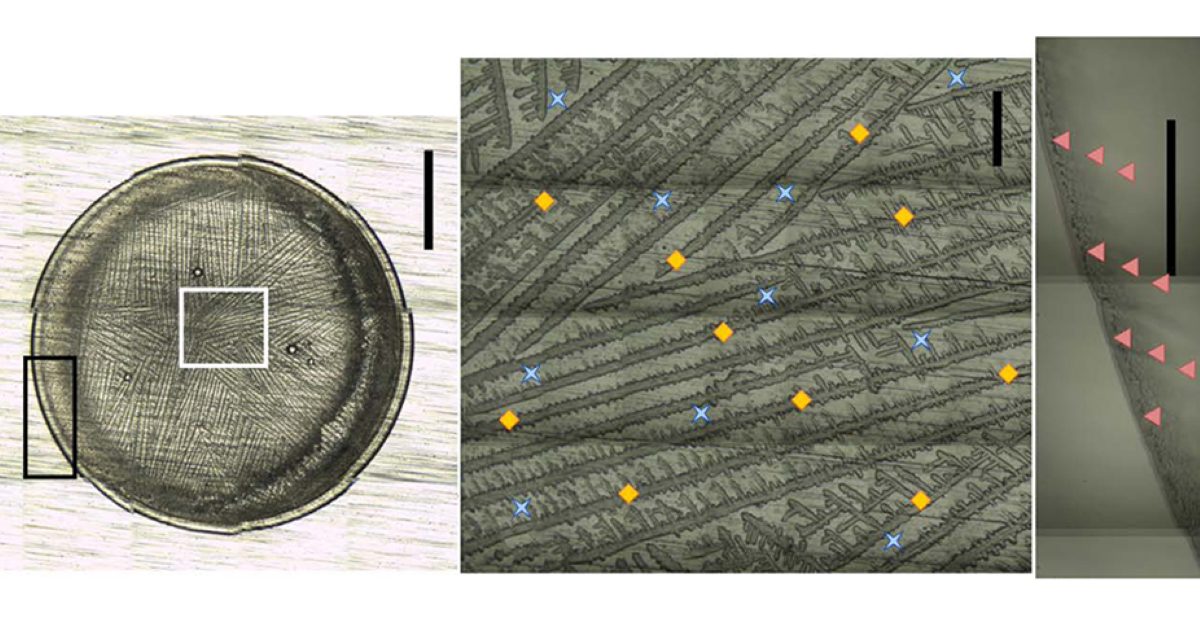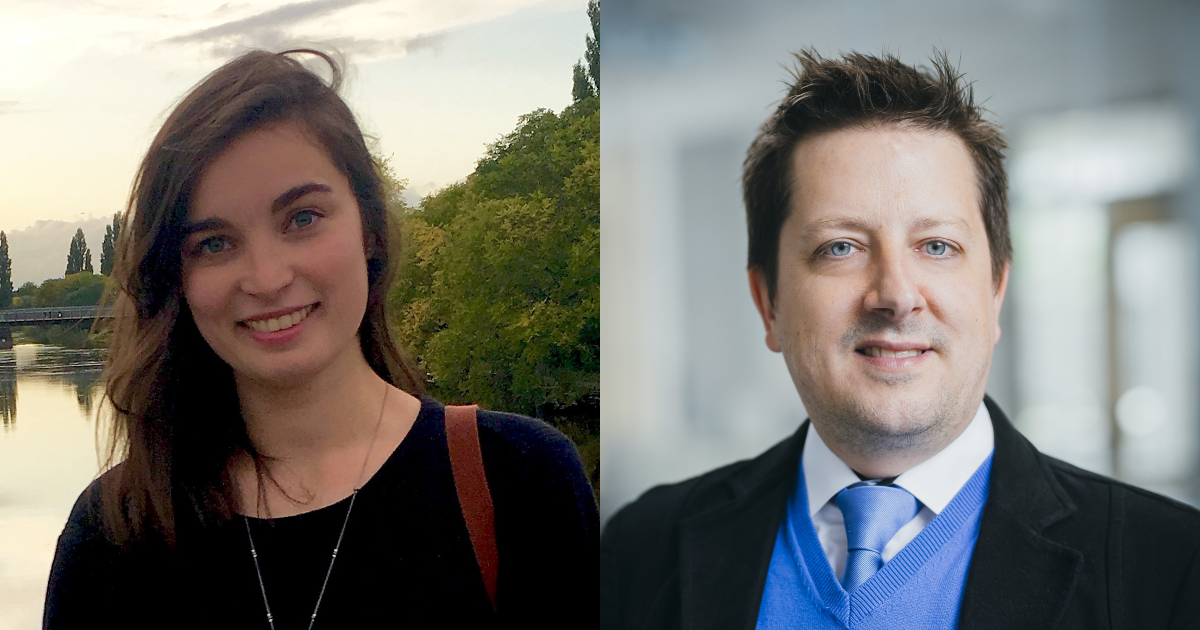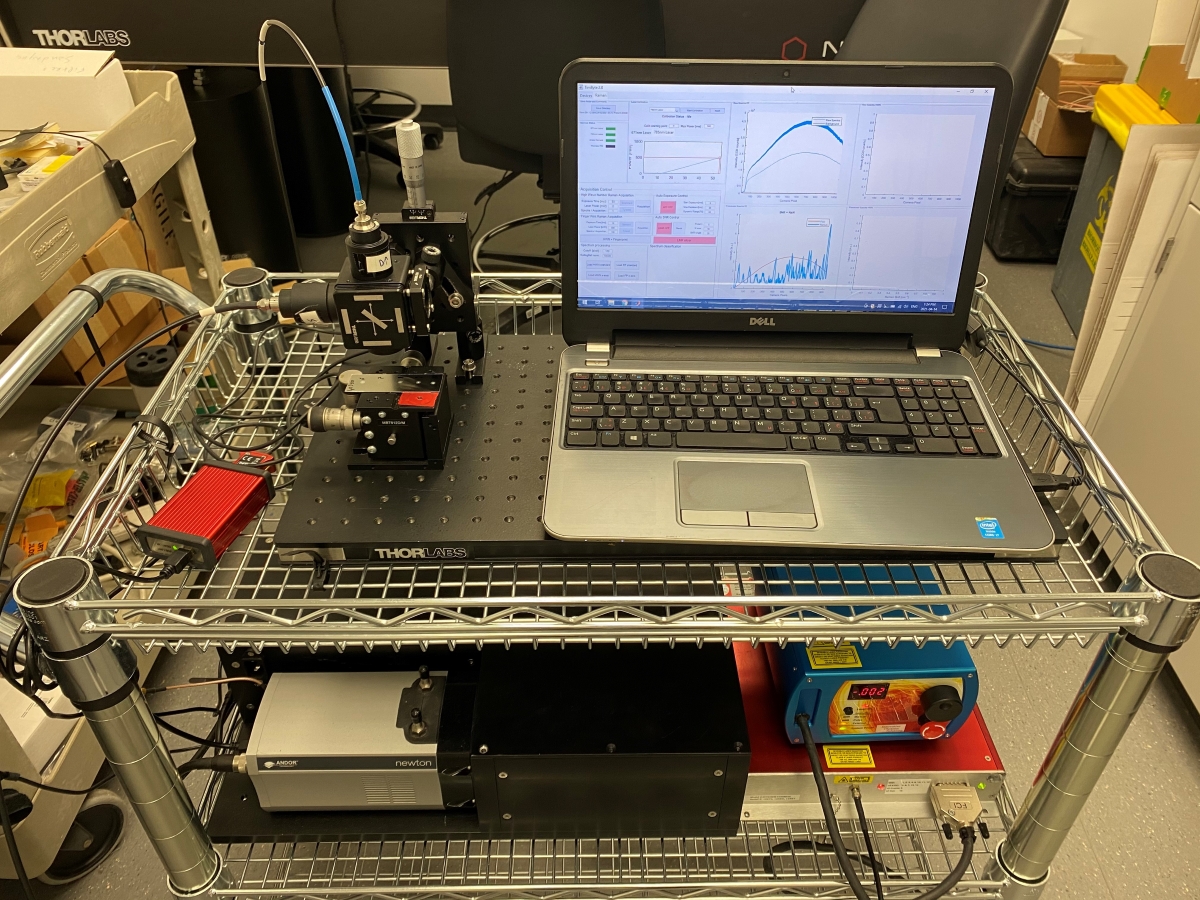Nouvelles
COVID-19: A new detection strategy developed at Polytechnique Montréal
A team from Polytechnique Montréal and the CRCHUM has just demonstrated how Raman spectroscopy and simple saliva samples could be used to quickly detect SARS-CoV-2, the virus causing COVID-19. The breakthrough was published today in an article the Journal of Biomedical Optics, and paves the way for Raman spectroscopy in biomedical analysis laboratories.

A single droplet of dried saliva is enough for Raman spectroscopy to identify whether or not a person is infected with the COVID-19 virus (Credit: Amber et al, JBO)
The pandemic has familiarized all of us with techniques used to identify the presence of viruses - PCR and immunochemical tests being just a few. While each of these approaches are accurate and reliable to a certain degree, they do have some shortcomings.
For example, PCR tests involve transporting samples to a clinical laboratory where tests are performed, which can lead to logistical challenges, but more specifically to delays in obtaining results. Further, both PCR and immunological tests require the use of reagents and equipment which ultimately have an undeniable environmental impact.
In the article he and his team are publishing today, Full Professor Frédéric Leblond (Department of Engineering Physics at Polytechnique Montréal), presents an alternative testing method based on Raman spectroscopy and machine learning - the latter being a form of artificial intelligence (AI). The approach makes it possible to determine whether or not a person is infected with the virus that causes COVID-19 using only a droplet of saliva on a slide.
FINDING THE SIGNATURE OF COVID-19

Katherine Ember, postdoctoral fellow (and the article's first author), and Professor Frédéric Leblond.
Professor Leblond's research team first analyzed 37 saliva samples from patients with COVID-19, plus 513 other samples taken from healthy patients, in order to train an automated learning tool to discriminate between samples from infected or healthy individuals.
In each case, a single droplet of dried saliva on a slide was used for training. Placed under a microscope lens, the sample was analyzed by Raman spectroscopy, leading to the creation of a series of “Raman scattering spectra.” These kinds of images can’t be seen by the human eye, but contain a COVID- 19 signature recognized by the AI tool.
“COVID-19 causes certain metabolic changes that are reflected in saliva composition. We don't yet know exactly what the tool perceives at the biomolecular level, but we know that it's able to correctly identify infected patients from uninfected ones," explains Professor Leblond.
To prove their method, after training the AI tool, the team presented it with samples it had not yet encountered. The tool identified positive cases with a success rate ranging from 79% and 84% while recognizing negative samples as negative with a success rate of 64% to 75% depending on whether the sample was from a male or a female donor.
“At this stage, our tool should indeed be further improved, but we're certain that we're on the right track," notes Professor Leblond.
Improving things is exactly what the group is busy doing.
The group has tested various means to improve the quality of samples used to train its algorithm, which even included them working with liquid saliva samples in order to reduce the time required to obtain an analysed result. The fastest time was about one minute.
The group also plans to unveil new results in June at a conference in Dublin, Ireland. According to Professor Leblond, the tool now identifies positive cases at more than 95% and identifies negative cases as true negatives with 80% success, which brings the tool closer to usability in real-life.
Eventually, the entire unit could be contained in a box the size of a microwave oven, thus making is able to be deployed in busy places to determine - in a few short minutes - whether an individual is infected or not.
A NEW TOOL IN THE BIOMEDICAL ANALYSIS ARSENAL

The small size of the experimental set-up used for this work makes it possible to envisage that one day the diagnostic tool will fit into a box the size of a microwave oven. (Photo: Nassim Ksantini)
Professor Leblond was instrumental in helping Raman spectroscopy to become established as a tool in the medical field, used to differentiate cancerous tissue from healthy tissue during surgeries. With this new article, Professor Leblond's team has demonstrated for the first time ever, that this approach could also find its way in medical analysis laboratories in order to recognize the signature of different pathologies in fluids such as saliva, blood or urine, for example.
“What we have here is a proof of concept that opens up a whole new field of applications. We can now consider detecting blood pathologies such as Lyme disease, or even the repercussions of a concussion," emphasizes Professor Leblond.
Such an approach would potentially accelerate the diagnosis of certain diseases in addition to replacing costly clinical tests.
This important work was carried out under the direction of Professor Leblond and was carried out in collaboration with Dr. Dominique Trudel, pathologist at the Centre hospitalier de l'Université de Montréal (CHUM). This phase of the research project received financial support from the Canada Foundation for Innovation (CFI), the TransMedTech Institute, IVADO and the Natural Sciences and Engineering Research Council of Canada (NSERC).
THE PRINCIPLES OF RAMAN SPECTROSCOPY IMAGING
Our eye perceives objects because it detects the light rays scattered by them. The Raman spectroscopy approach used by Professor Frédéric Leblond acts in the same way, with one difference: it discerns light rays whose wavelength has changed when hitting an object.
Each substance modifies in this way the light that is projected on it, generating a true "molecular signature" specific to the illuminated substance. The Polytechnique Montreal and CRCHUM team has just demonstrated that the saliva of individuals with COVID-19 offers a distinct signature from that of healthy patients, either by the presence of viral particles or by molecules manufactured by the organism in response to the viral attack.
Learn MORE
Professor Frédéric Leblond's expertise
The article published in Journal of Biomedical Optics
Departement of Engineering Physics website
Centre de recherche du CHUM (CRCHUM) website (In French)



